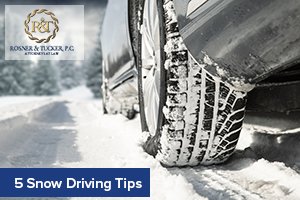Driving in snow can be challenging for even the most experienced driver. The American Automobile Association offers winter driving tips. Even if you are an old hat at snow driving, a refresher course won’t hurt – and might help in severe weather.
Snow Driving Means Slow Driving
When you are driving in snow, slow down! Understand and plan for the fact everything takes longer in snow than it does in dry conditions.
The posted speed limit is for optimal driving conditions. Snow-covered roads are not optimal conditions in anyone’s book. Consequently, you should drive at less than the speed limit.
Accelerate and Decelerate Slowly
The “everything” that takes longer in snow than it does in dry conditions includes both acceleration and deceleration. You should gently apply slow and steady pressure to the gas pedal. This is the best way to obtain, maintain, and regain traction on the road. It is also the best way to avoid skidding out. When braking, plan ahead. Start braking well in advance of when you actually need to stop. When braking, apply firm, steady pressure on the brake pedal.
If Your Car Goes Off the Road
In the unfortunate event your car goes off the road, and you are unable to return to the road, stay with your vehicle. It is far easier to locate a vehicle than a lone person wandering. Your vehicle provides a place of temporary safety. It will shield you from the wind and snow. Tie a brightly colored cloth to your antenna, or insert a cloth at the top of a rolled-up window, so rescuers can see you more easily and to signal distress. The dome light only takes a small amount of battery. Consider leaving it on during the night. Allow the car to run periodically to warm up.
Be Aware of the Exhaust
Your car produces carbon monoxide, which is vented through your exhaust system. This can kill you if inhaled in large quantities. Never warm up your car in a closed area, such as a garage. If your car is stuck in the snow, make sure the exhaust pipe isn’t clogged with snow or ice. This can result in carbon monoxide poisoning as the gas leaks into the passenger compartment while you run the car. This cannot be stressed enough. Carbon monoxide poisoning can kill you.
Avoid Snow Driving All Together
When it is snowing, your odds of an accident increase. Consider whether the trip you plan to take is essential to your well-being, or whether the trip can be delayed by a few hours or even a few days. Your safety is paramount. If you can stay home, AAA recommends you stay home. Even if you feel confident in your ability to drive in snow, not everyone on the road may be as skilled as you are. Stay safe! Stay home!
Snow Driving Can Lead to Car Accidents
If you have been injured due to a car accident in the snow, you may be entitled to compensation for your injuries. At Rosner Law Offices, P.C., we offer a free consultation to discuss your case. There is no cost to you unless we recover compensation for your injuries. Contact us to discuss your situation today at (856) 502-1655
Additional Reading



 Call Us
Call Us Text Us
Text Us Email Us
Email Us